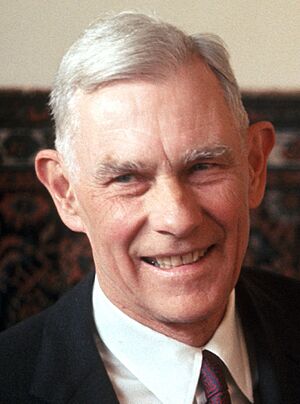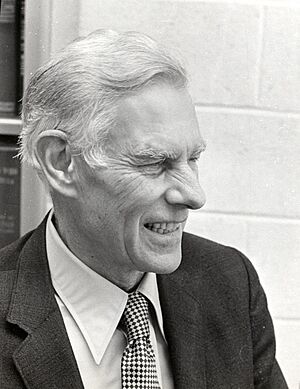David M. Dennison facts for kids
Quick facts for kids
David Mathias Dennison
|
|
|---|---|

Dennison at his home in Ann Arbor, Michigan, 1969
|
|
| Born | 26 April 1900 |
| Died | 3 April 1976 |
| Alma mater | Swarthmore College University of Michigan |
| Scientific career | |
| Doctoral advisor | Walter F. Colby Oskar Klein |
| Notable students | Nelson Fuson |
David Mathias Dennison (born April 26, 1900, died April 3, 1976) was an American scientist. He was a physicist who studied tiny particles and how molecules are built. He helped us understand quantum mechanics, which is the science of very small things, and spectroscopy, which is about how light interacts with matter. His work also explained the structure of molecules.
Contents
Dennison's Early Life and Learning
David Dennison started college at Swarthmore College in 1917. He finished his studies there in 1921. After that, he went to the University of Michigan in Ann Arbor. There, he studied physics with his professors, Walter F. Colby and Oskar Klein.
Learning from the Best in Europe
Oskar Klein had worked with Niels Bohr, a famous physicist, in Denmark. Through Klein, David Dennison learned about the newest ideas in physics from Europe. This made him want to go to Copenhagen to study more.
David finished his advanced studies in 1924. His main project was about the structure of the methane molecule and how it absorbs infrared light.
Studying Across Europe
From 1924 to 1926, David Dennison received a special scholarship. This allowed him to do more research in Europe. He spent most of this time at the Institute of Theoretical Physics in Copenhagen, Denmark.
While there, he met many other brilliant physicists. These included Paul Dirac, Werner Heisenberg, and Wolfgang Pauli. In 1925, Heisenberg and Max Born introduced a new way to understand quantum mechanics called matrix mechanics.
In 1926, David went to Switzerland to work with Erwin Schrödinger. Schrödinger had just created his own way to understand quantum mechanics, known as wave mechanics. David then returned to Copenhagen and later visited the University of Cambridge in England. He also spent some time in the Netherlands.
Discovering Proton Spin
In 1925, two scientists, George Eugene Uhlenbeck and Samuel Abraham Goudsmit, suggested that tiny particles have a property called spin. Also, Wolfgang Pauli introduced the Pauli exclusion principle. This rule explains how particles behave.
While at Cambridge, David Dennison used quantum mechanics to study hydrogen molecules. He showed that protons, like electrons, also have spin. This meant protons follow the same rules as electrons, including the Pauli exclusion principle.
Dennison's Career at Michigan
In 1927, David Dennison came back from Europe. He began his long career at the University of Michigan, where he worked until 1976. He joined Otto Laporte, George Uhlenbeck, and Samuel Goudsmit. Together, these four scientists helped build the university's strong physics department. They focused on developing the field of theoretical physics, including quantum mechanics.
Solving Molecular Mysteries
Most of David Dennison's work focused on the structure of molecules. After the discovery of electron spin in 1925, scientists were puzzled by the specific heat of hydrogen. This was a big problem that needed solving.
In 1927, David Dennison found the answer. He suggested that the spin of protons does not change often during measurements. This new idea perfectly matched what scientists observed in experiments. It also confirmed that protons have a spin of 1/2.
In 1932, David Dennison and George Uhlenbeck solved another puzzle. They figured out the "reversing umbrella" problem for nitrogen in ammonia. This work predicted that ammonia would absorb microwave energy. This inspired another scientist, Neal H. Williams, to build one of the first molecular microwave spectrographs.
Contributions During Wartime
During World War II, David Dennison helped the US Navy. He worked on the VT radio proximity fuse, a device that helped bombs explode closer to their targets. For his important work, he received an award from the Navy.
After the war, David went back to studying molecular structure. He also helped design a new particle accelerator called a synchrotron at Michigan. With Theodore H. Berlin, he developed ideas for stable orbits in synchrotrons. These ideas are now used in most large synchrotrons around the world.
Dennison's Legacy
The David M. Dennison Building at the University of Michigan was once named in his honor. Later, it was renamed the Weiser building. However, the main lecture hall for the physics department is still named after Dennison. Also, a place in Antarctica called Dennison Reef is named to honor him.


